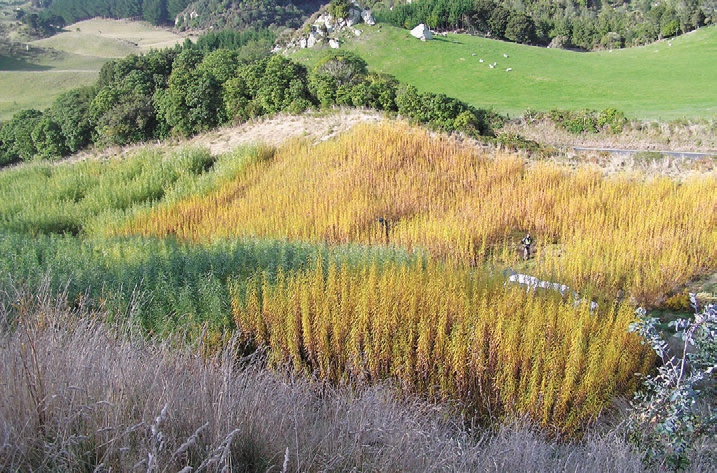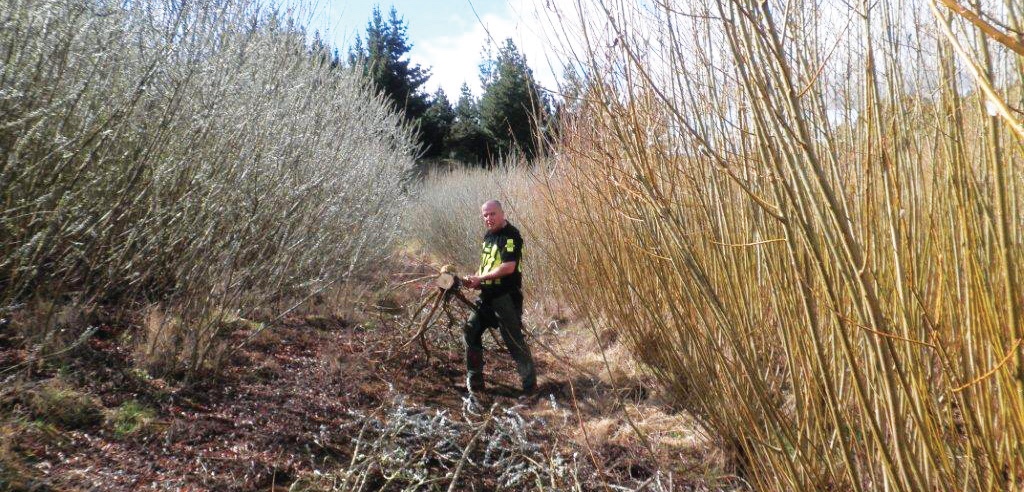Willow biomass in the Taupo region
Ian Nicholas, Kevin Snowdon and Ian McIvor, New Zealand Tree Grower November 2010.
The growth of shrub willows have been investigated for bioenergy and as a biopolymer resource in the Taupo area since 2004. Background information and some results have been presented in previous Tree Grower articles in November 2007; and February 2009.
| Biomass productivity from trial plantings at three years | ||
|---|---|---|
| Treatment | Mean | Range |
| Oven dry tonnes per hectare | Oven dry tonnes per hectare | |
| Salix schwerinii | 12.19 | 6.3 to 24.3 |
| Salix purpurea | 9.25 | 2.8 to 22.8 |
| Salix viminalis | 8.87 | 1.9 to 22.3 |
| 20 cm cutting | 8.15 | 4.8 to 22.8 |
| 25 cm cutting | 10.51 | 3.3 to 20.2 |
| 33 cm cutting | 11.76 | 2.6 to 24.3 |
| Cultivated | 10.88 | 2.2 to 24.3 |
| Not cultivated | 9.34 | 1.9 to 22.3 |
Two of the project plantations were also assessed for biomass production. A demonstration planting west of Lake Taupo was established in 2004, and another a larger scale trial north of Taupo established in 2005. The large scale trial evaluated species, cutting length and the effects of site preparation.
This trial was assessed after three years, but growth had been affected by lack of rainfall during the critical growing periods. No significant differences were found in treatments within the sub-trials.
The productivity was 10.2 oven dry tonnes per hectare for the eight treatments in the trial after three years. The amount varied from 8.15 to 12.19 oven dry tonnes per hectare, but there was considerable variation within each treatment as shown in the table. Within the 53 plots in the trial there were eight plots producing over 15 tonnes per hectare and four of these produced over 20 tonnes.

Productivity
Biomass was also measured in the demonstration trial which has had more regular rainfall than the site north of Taupo. This site was coppiced in 2007 and biomass data was collected from plots of Salix viminalis and S. schwerinii in 2008, 2009 and 2010.
| Biomass productivity from demonstration plantings after coppicing | ||||
|---|---|---|---|---|
| S. viminalis | Range | S. schwerinii | Range | |
| Oven dry tonnes per hectare |
Oven dry tonnes per hectare |
Oven dry tonnes per hectare |
Oven dry tonnes per hectare |
|
| Year 1 | 7.8 | 7.2 to 8.6 | 11.1 | 8.6 to 12.5 |
| Year 2 | 11.1 | 8.6 to 13.0 | 13.0 | 10.7 to 15.5 |
| Year 3 | 17.0 | 15.5 to 18.4 | 18.1 | 12.7 to 23.6 |
The productivity of the demonstration planting is considerably higher than the trial plantings north of Taupo, although there is considerable variation between the plots. This is possibly from the better rainfall in this area, despite there being less than normal rainfall for two of the years the coppice has been growing.

being taken for weighing
The good productivity may also be a result of the older root systems generating the coppice. However the root age is what would be expected from a typical second rotation managed stand.
The results from these biomass studies indicate that short rotation willow plantations can be quite productive. The most productive species has been S. schwerinii, but it also has shown the most variation between plots. The S. viminalis has also performed well and has been a consistent performer across both sites. The results of these plantations gives confidence that willow could provide a planting option for generating bioenergy or biopolymer resources.

 Farm Forestry New Zealand
Farm Forestry New Zealand